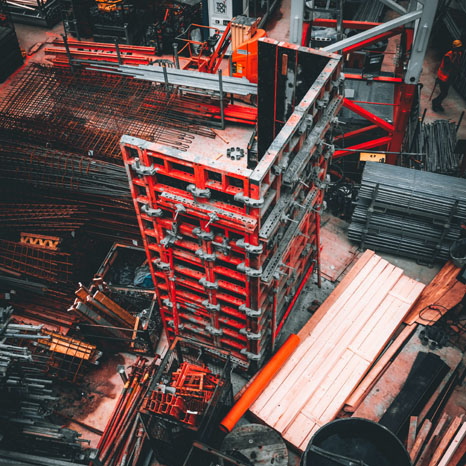Types of building materials commonly used in construction
 Building materials are at the heart of the construction industry. Think about it; no structure can be erected without some form of building materials. These materials are what come together to form a structure.
Building materials are at the heart of the construction industry. Think about it; no structure can be erected without some form of building materials. These materials are what come together to form a structure.
There are different kinds of building materials used in construction. They range from naturally occurring substances such as clay and wood to man-made substances like concrete and steel.
Each material has different properties such as density, strength, durability, load-bearing capabilities, stress resistance, and more. These properties define the suitability of these materials based on certain applications.
While there are numerous kinds of building materials, we focus our attention on the most common ones in this post.
- Steel
Steel is an alloy made up of iron and carbon content that can range from 0.03{ffa1fb9a833dbe70b91c2563ca2a54067368c324c18ffac54b9412388222efff} up to 2{ffa1fb9a833dbe70b91c2563ca2a54067368c324c18ffac54b9412388222efff}. Steel also contains trace amounts of manganese, silicon, phosphorus, sulfur, and oxygen. The presence of carbon in steel increases its hardness and strength. This makes steel one of the strongest building materials available.
Here are some of the unique properties of steel:
1) Steel is relatively easy and fast to install.
2) It has a high strength-to-weight ratio. This makes it ideal for the structural framework of tall buildings and industrial facilities.
3) Steel is expensive compared to other building materials.
4) It is highly susceptible to corrosion if routine maintenance is neglected.
- Concrete
Concrete is a composite construction material composed of cement, fine aggregates (like sand), and coarse aggregates (like gravels, stone chips, and pebbles) mixed with water which hardens with time.
As you can easily guess, the property of concrete strongly depends on the proportions of each of its principal components. However, here are some of the general properties of concrete:
1) Concrete can take any shape and form, making it easy to work with.
2) It is highly durable because it is extremely resistant to physio-chemical attacks emanating from the environment (rain, frost, pollution, etc).
3) It has high mechanical strength, in particular compressive strength.
The high strength and durability of concrete make it an excellent material choice for building foundations.
When concrete is combined with reinforcement steel bars, it is referred to as reinforced concrete. Reinforced concrete simultaneously utilizes the compressive strength of concrete and the tensile strength of steel. This enhanced property makes reinforced concrete suitable for a wide range of structures like roads, tall buildings, bridges, and tunnels, among many others.
- Wood
Wood (or timber) is mankind’s oldest construction material. For thousands of years, it’s been used in building houses, bridges, barns, and a whole lot of other structures. When maintained properly, wood can last for hundreds of years.
Here are some of the properties of wood in construction:
1) Because it is naturally occurring, it is readily available and economical.
2) It is relatively lightweight.
3) It is highly machinable, making it easy to standardize in size. Standardized wood is referred to as dimensional lumber.
4) Its excellent insulation property makes it ideal for residential buildings.
5) It has high tensile strength.
6) Wood is susceptible to degradation from water, rot, and insect. That’s why wood needs to be pressure-treated to make it suitable for certain applications.
- Masonry (or Brick)
Masonry consists of building structures from single units that are laid and bound together with mortar. Some of the most common materials used in masonry construction include brick, stone, and concrete blocks (which are the strongest).
Here are some of the properties of masonry:
1) Because it is made from smaller units, it provides great design flexibility.
2) It has high structural strength.
3) Masonry is fire-resistant, mold-resistant, and highly durable.
4) It can easily withstand high compression loads, making it suitable for load-bearing walls.
5) It is very easy to maintain.
6) It is cost-competitive.
These properties of masonry make it suitable for walls and buildings.
- Stone
Humans have used stones for a very long time. Remember the Stone Age that lasted for over 2.5 million years, where humans used primitive stone tools. This also makes stone one of the oldest construction materials.
Some of the popular ancients buildings – like Stonehenge and the Ancient Greek Parthenon – were made from stones. And even today, stones continue to play an integral role in construction. Examples of modern stone buildings include Casa Mila in Barcelona and the Taj Mahal.
Here are some of the properties of stone:
1) Stone is very dense and heavy. This makes it difficult to work with.
2) It is a poor insulator.
3) It is fire-resistant and durable.
4) It is hard and tough.
Wrap Up
The construction industry will be non-existent without building materials. We’ve examined five of the most common building materials. But there are a whole lot of materials used in this industry. Some of them include mud and clay, thatch, brush, ice, glass, ceramic, and plastic.
But at the end of the day, the materials of choice for a construction project are determined by its purpose and design constraints.
We’re here to help. Contact us today for more information – we look forward to working with you on your next project!

